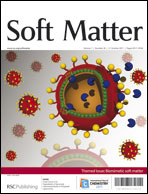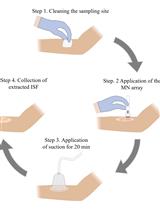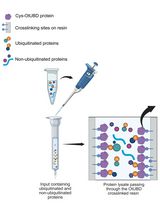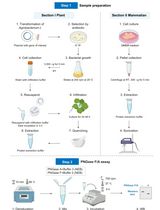- EN - English
- CN - 中文
Preparation of Silk Fibroin Nanoparticles and Enzyme-Entrapped Silk Fibroin Nanoparticles
制备丝素蛋白纳米颗粒和酶包裹丝素蛋白纳米颗粒
发布: 2018年12月20日第8卷第24期 DOI: 10.21769/BioProtoc.3113 浏览次数: 8708
评审: Bedabrata SahaMahfoudh Almusali Mohammed AbdulghaniAnonymous reviewer(s)
Abstract
After silk fiber is degummed in boiling 0.2% Na2CO3 solution, the degummed fibroin fiber could be dissolved in highly concentrated neutral salts such as CaCl2. The partially degraded polypeptides of silk fibroin, commonly called as regenerated liquid silk, could be obtained via water dialysis. The silk fibroin nanoparticles (SFNs) or enzyme-entrapped SFNs are prepared rapidly from the liquid silk by using acetone. The globular particles with a range of 35-125 nm in diameter, are water-insoluble but well dispersed and stable in aqueous solution. The nanoparticles are potentially useful in biomaterials such as cosmetics, anti-UV skincare products, and surface improving materials, especially in enzyme/drug delivery system as vehicle. Here, a detailed protocol for SFNs and enzyme-entrapped SFNs preparation is described.
Keywords: Silk fibroin (蚕丝蛋白)Background
The development of silk fibroin as a biomaterial, especially biomedical tissue engineering materials, has been a hot topic in recent decades. Natural silk fiber from Bombyx mori has to undergo a series of processing steps to become a regenerated liquid silk fibroin. The liquid silk can be easily made into various forms of silk biomaterials, such as micro- or nano-particles, regenerated fibers, artificial skin, and porous matrix or 3D scaffolds, biomimetic nanofibrous scaffolds, a platform for transistors and various classes of photonic devices. The structure and properties of the final forms of silk biomaterials depend evidently on the molecular size of the regenerated liquid silk which is affected by a series of processing steps including degumming and fibroin fiber dissolution. Our investigation showed that boiling and degumming in a 0.1%-0.5% Na2CO3 solution used most frequently in the laboratory can not only cause a large amount of sericin degradation and hydrolysis but also leads to serious breakage of the silk fibroin peptide chain and its mechanical properties decreasing (Wang and Zhang, 2013). The low purity, high concentration, and improper storage conditions easily induce regenerated liquid silk gelling or coagulating and denaturing. The partially chain-broken polypeptides of silk fibroin can be converted into silk fibroin nanoparticles (SFNs) in acetone (Zhang et al., 2007). During this process the molecular structure of the regenerated liquid silk has changed rapidly from random-coil and a-helix form (Silk I) into anti-parallel β-sheet form (Silk II). The resulting crystalline silk nanoparticles may offer various possibilities for surface modification of industrial materials and enzyme/drug delivery system (Zhang et al., 2011).
Materials and Reagents
- Qualitative Filter Paper, 0.22 μm, Round, 15 cm (Sangon Biotech (Shanghai) Co., Ltd., catalog number: F503312)
- Dialysis membrane (Standard, RC, 5 KD, 18 mm Width) (BBI, catalog number: F128058)
- The cocoons of silkworm Bombyx mori, provided by Sericultural Institute, Soochow University, Suzhou, P. R. China
- Na2CO3 (Sangon Biotech (Shanghai) Co., Ltd., catalog number: A500840)
- CaCl2 (Sangon Biotech (Shanghai) Co., Ltd., catalog number: A501330)
- Ethanol (Sangon Biotech Shanghai Co., Ltd., catalog number: A500737)
- Acetone (Sigma-Aldrich, catalog number: 320110)
- Polyethylene glycol-2000 (Sangon Biotech (Shanghai) Co., Ltd., catalog number: A601785)
- 50 mmol/L phosphate buffer (pH 7.0) (see Recipes)
- Ajisawa's reagent (CaCl2/ethanol/H2O [1:2:8 molar ratio]) (see Recipes)
Equipment
- Glass Injector, 20 ml
- Glass beaker, 50 ml
- High-speed Refrigerated Centrifuge (Beckman Coulter, model: Avanti® J-30I)
- Scanning Electron Microscope (Hitachi, model: S-570)
- Ultra-sonic Instrument (Sonics Vibra cell) (Sonics & Materials, model: VCX 130 PB)
Procedure
文章信息
版权信息
© 2018 The Authors; exclusive licensee Bio-protocol LLC.
如何引用
Zhang, Y. Q. (2018). Preparation of Silk Fibroin Nanoparticles and Enzyme-Entrapped Silk Fibroin Nanoparticles. Bio-protocol 8(24): e3113. DOI: 10.21769/BioProtoc.3113.
分类
生物化学 > 蛋白质 > 修饰
生物物理学 > 生物工程 > 医用生物材料
您对这篇实验方法有问题吗?
在此处发布您的问题,我们将邀请本文作者来回答。同时,我们会将您的问题发布到Bio-protocol Exchange,以便寻求社区成员的帮助。
Share
Bluesky
X
Copy link













